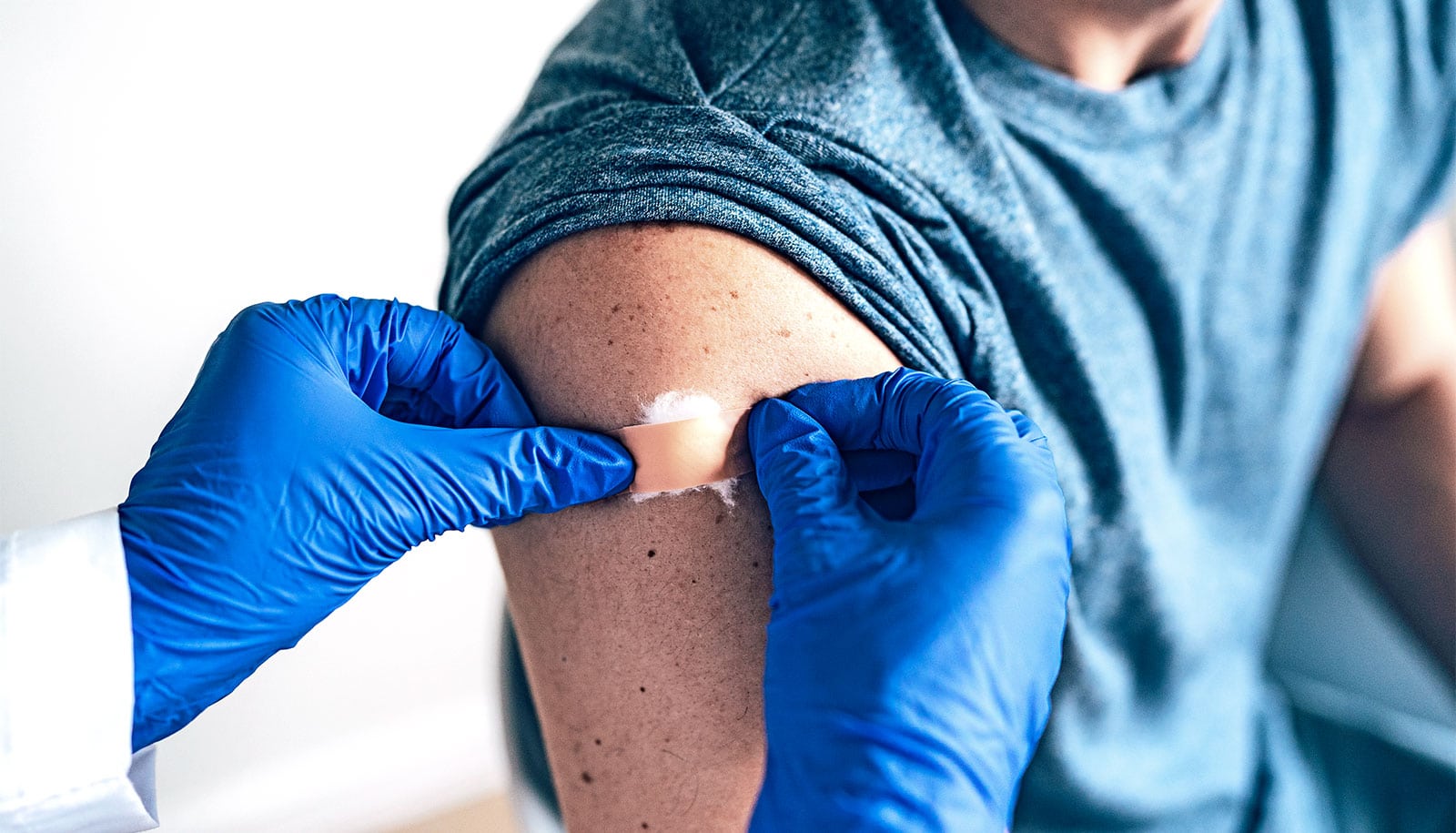Experts from Yale University have answers for you about the newly updated COVID-19 vaccines.
There will be better protection against severe disease, hospitalization, and death from COVID-19 in the coming months now that newly updated (2023–2024 formula) mRNA COVID vaccines are available. The new shots are expected to keep more people from getting seriously ill with the virus through the winter, when infections and hospitalizations tend to tick upwards. And unlike the spring booster that targeted people ages 60 and older, these updated vaccines are for everyone ages 6 months and older.
The Food and Drug Administration (FDA) and the Centers for Disease Control and Prevention (CDC) approved the updated vaccines by Pfizer-BioNTech and Moderna in mid-September. (In early October, they also authorized an updated Novavax vaccine for use in individuals 12 and older; more on that below.)
The vaccines target XBB.1.5, a subvariant of Omicron that dominated the United States—and the world—from November 2021 until earlier this year. The CDC says the updated vaccines should also work against currently circulating variants of the SARS-CoV-2 virus—many of which descended from, or are related to, the XBB strain. This includes EG.5, the dominant strain in the US, and BA.2.86, a new subvariant sparking concern because it has more than 30 mutations to its spike protein.
While COVID-19 has been causing mostly mild illness recently, Yale Medicine infectious diseases specialist Onyema Ogbuagu reminds people that the disease can still lead to hospitalization and death.
“Infections can have long-term consequences,” Ogbuagu says, adding that even healthy people can develop Long COVID—a condition in which new, continuing, or recurring (and sometimes debilitating) symptoms are present four or more weeks after an initial coronavirus infection.
Here, Yale experts tell you what you need to know about the updated COVID vaccine:
Why would another COVID vaccination help?
The updated vaccines are not expected to prevent all cases of COVID, including those causing mild illness; rather, their aim is to reduce severe illness, hospitalization, and death from infection. According to the CDC, COVID is still a major cause of serious respiratory illness, with more than 200,000 reported deaths since January 2022. That figure includes more than 600 deaths in adolescents and children ages 19 and younger.
Older people (especially those ages 50 and older) are more likely than younger people to get very sick from COVID. Immunocompromised people and those with chronic medical conditions, such as diabetes or heart disease, are at the highest risk of severe disease and death, but some young, healthy people have also gotten very ill and died from COVID. In addition, the CDC recommends the vaccine for pregnant women to protect both mother and baby.
An analysis by the CDC suggested that making its vaccine recommendation universal could prevent 400,000 hospitalizations and 40,000 deaths in the US over the next two years.
How is the updated COVID vaccine different from the previous one?
The bivalent booster, which is no longer available, was introduced in the fall of 2022. It targeted the BA.4 and BA.5 Omicron subvariants and the original SARS-CoV-2 virus. The new vaccine is monovalent, designed to prevent severe disease from the Omicron XBB.1.5 subvariant. By September, the long-running XBB.1.5 accounted for only about 3% of cases in the US, but most of the strains circulating now are descended from (or closely related to) it.
That’s a good example of how the virus has evolved—and it’s still evolving—so rapidly that it may be impossible to match each new vaccine update to the variants circulating at the time it is released, explains Scott Roberts, a Yale Medicine infectious diseases specialist.
“But we know from experience that the vaccines hold up very well, even against multiple variants, unless there is a significant shift like we saw with Delta to Omicron in the winter of 2021,” he says. “Basically, if you have some immunity to a variant and are exposed to a new offshoot of it, you’ll have some protection.”
Why isn’t the new COVID vaccine considered a booster?
The FDA is calling the new shots “updated vaccines” in anticipation of needing to provide updated formulas annually, similar to the flu shot, which changes each year.
A booster shot gives a “boost” to the recipient’s existing immunity from a previous vaccination. Updated vaccines are different in that they are expected to provide protection against currently circulating variants, helping the body build a new response to those variants. “Barring the emergence of a markedly more virulent variant, the FDA anticipates that the composition of COVID-19 vaccines may need to be updated annually, as is done for the seasonal influenza vaccine,” the FDA noted in its approval and authorization of the new vaccine.
“I think we’re going to fall into a pattern very similar to the flu, where every year the virus is going to mutate slightly, and the vaccine formulation for the fall will be an educated guess,” says Roberts. “We will make a vaccine targeted against whatever we predict or whatever is currently circulating and hope our vaccines are a good match, because we will be developing them before we know what variants will be circulating in the fall.”
Will this COVID shot protect against Omicron strains EG.5 and BA.2.86?
It’s a good question, considering EG.5 made up 29.4% of cases at the end of September, more than any other SARS-CoV-2 virus strain at the time, followed by another XBB descendent called FL 1.51, which accounted for 13.7% of cases.
“The XBB characteristics of the shot are genetically similar to EG.5,” Roberts says. “They’re not identical, but they’re pretty close. So, there’s going to be protection with the updated vaccine.”
There is still more to learn about BA.2.86, which appeared in the US in August and is not reported to be widespread in this country at this point. The multiple mutations to its spike protein could be a sign that it is more transmissible or could cause more severe disease, although so far, nobody knows for sure. However, the CDC says the new shots should work against the new strain.
How safe is the updated COVID vaccine?
The benefits of the COVID-19 vaccine continue to outweigh any potential risks, and serious reactions after COVID-19 vaccination are rare, according to the CDC. The agency cited a study showing the risk of cardiac complications, including myocarditis (an inflammation of the heart muscle), in males 12-17 years old was 1.8–5.6 times higher after a COVID-19 infection than after COVID-19 vaccination.
Are there any special COVID vaccine recommendations for children?
The FDA approved the updated mRNA vaccines for adolescents and teenagers ages 12 and older and authorized them for emergency use in children ages 6 months through 11 years.
Children are less likely to get seriously ill with COVID, but some still do, says Magna Dias, a Yale Medicine pediatric hospitalist. She tells parents who are still not sure whether they should get the vaccine for their children to talk to their pediatrician, especially if their child is immunocompromised.
“In that case, I think it’s a no-brainer to protect them,” she says.
Is there an updated COVID vaccine from Novavax?
The FDA authorized an updated version of a vaccine Novavax developed to target the XBB.1.5 strain. Individuals 12 and older previously vaccinated with a COVID-19 vaccine (and who have not already been vaccinated with a recently updated mRNA COVID-19 vaccine) are eligible to receive one dose; unvaccinated individuals can receive two doses.
According to the FDA, the updated vaccine addresses currently circulating variants to provide better protection against serious consequences of COVID-19, including hospitalization and death.
The Pfizer-BioNTech and Moderna vaccines use messenger RNA (mRNA) technology, which instructs the body’s cells to make proteins that trigger an immune response against COVID-19. The Novavax protein-based vaccine uses an older, more traditional technology and a different mechanism—it directly injects the spike protein (formulated in a laboratory) and another ingredient into the body, leading to the production of virus-fighting antibodies and T cells. The Novavax vaccine is the only non-mRNA COVID-19 vaccine available in the US.
When should I get the updated COVID vaccine?
Roberts encourages people to get their shot in October for immunity that will last through the middle of winter, when cases are expected to peak. The shot will boost immunity within two weeks, and maximal vaccine protection is usually in the first three months after the shot, he says.
“I would say October is when you want to start thinking about getting it, anticipating that November, December, and January will be the rough period.”
Should I get the updated COVID vaccine and other seasonal shots at the same time?
The CDC considers it safe to get the COVID shot and annual flu vaccine simultaneously. There is even research in progress to explore the effects of administering both vaccines in a single shot.
But the respiratory syncytial virus (RSV) vaccines for older adults and pregnant women (who can pass the antibodies along to their newborns) are brand new this fall, and there isn’t data to say for sure whether giving those at the same time as the other two shots is the best strategy.
Where can I get the updated COVID vaccine?
As with previous COVID-19 vaccines, this one will be available at participating pharmacies and provider offices. To find a location near you that carries the vaccine and to schedule an appointment, go to Vaccines.gov. You can also call 1-800-232-0233 (TTY 1-888-720-7489). Be aware that current distribution and insurance issues may delay availability of the vaccines temporarily in some places.
According to the CDC, the vaccines are covered by insurance, including private insurance, Medicare plans, and Medicaid plans. Uninsured children and uninsured adults also have access through the Vaccine for Children Program and Bridge Access Program, respectively.
Note: Information in this article was accurate at the time of original publication. Because information about COVID-19 changes rapidly, we encourage you to visit the websites of the Centers for Disease Control & Prevention (CDC), World Health Organization (WHO), and your state and local government for the latest information.
Information provided in Yale Medicine articles is for general informational purposes only. No content in the articles should ever be used as a substitute for medical advice from your doctor or other qualified clinician. Always seek the individual advice of your health care provider with any questions you have regarding a medical condition.
Source: Yale University



